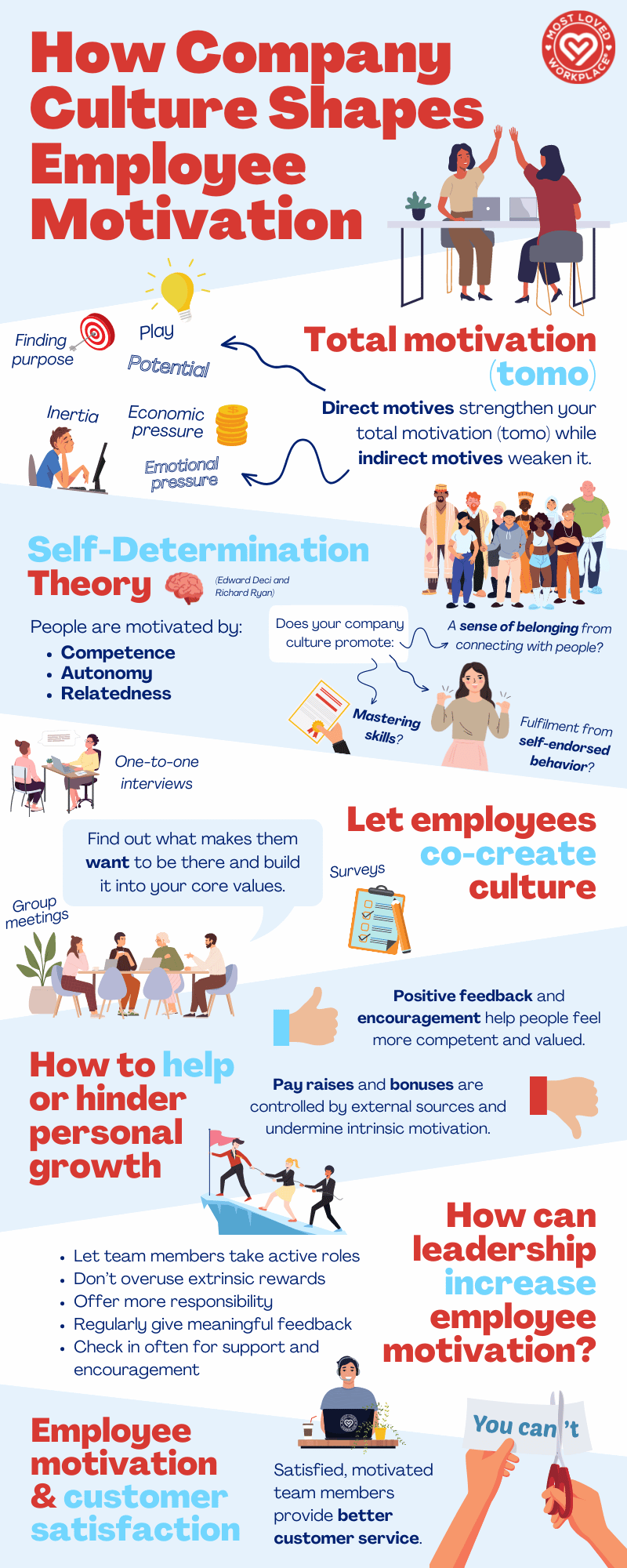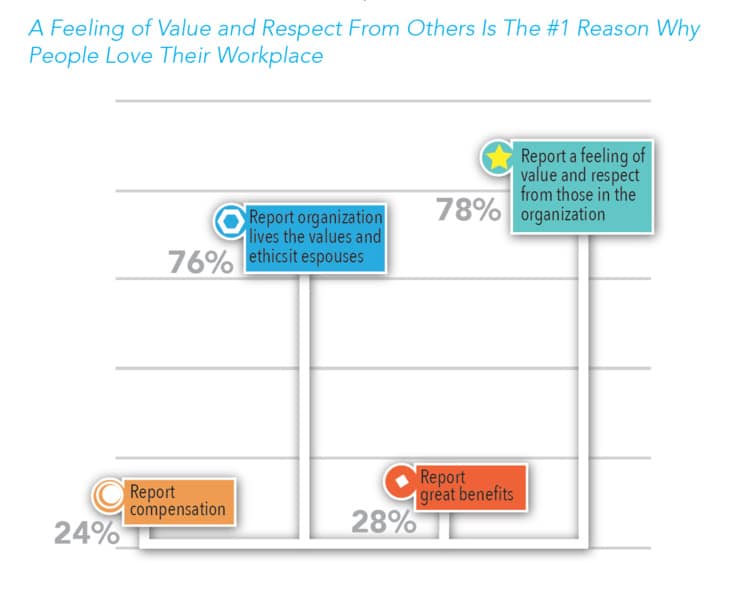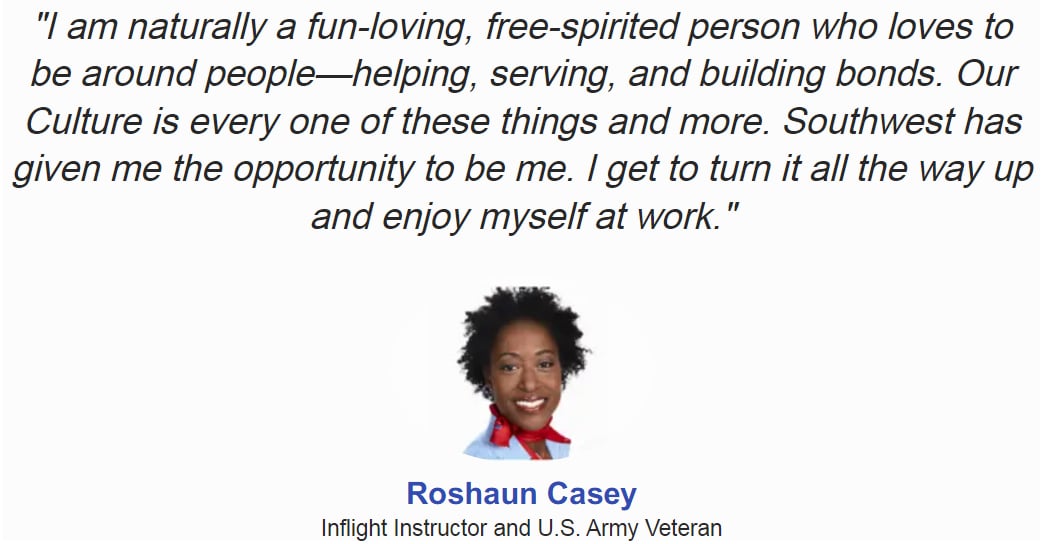How Company Culture Shapes Employee Motivation [Infographic]
What is the basis of your company culture? Is it the values you hold? The people? If you don’t realize it’s all of the above, there’s work to be done.
Culture can turn into a buzzword without the proper implementation behind it. The larger your company gets, the harder it is to build and maintain it. However, without it, the level of motivation your employees have will widely vary. So, how do you know what kind of strategy would help them all thrive?
This short guide explores why people work and what we, as employers, can do to update our culture to satisfy everyone’s psychological need to progress and grow. Here’s how company culture shapes employee motivation:
- Why do people work?
- Employee engagement vs. motivation
- What makes up company culture?
- How can leaders increase employee motivation?
- Employee motivation and customer satisfaction are linked

Why Do People Work?
There are many reasons why people choose to work:
-
- Play (enjoyment) – you have a strong learning instinct and like solving problems
- A sense of purpose – you want to feel like you contribute to society or your household
- Potential for development – you are keen to climb the career ladder and better yourself
- Economic pressure – work is a financial obligation to fund your lifestyle
- Emotional pressure – only because others expect you to (through peer pressure or shame)
Your total motivation (tomo) will be made up of a few of these factors. Lindsay McGregor is the best-selling author of Primed to Perform: How to Build the Highest Performing Cultures Through the Science of Total Motivation. She believes an employee’s total motivation comes from a combination of direct and indirect motives that are constantly playing against each other.
|
Direct motives (strengthen) |
Indirect motives (weaken) |
|
Play and enjoyment |
Emotional pressure |
|
Purpose |
Economic pressure |
|
Potential for competitive advantage |
Inertia (a tendency to do nothing) |
Of course, unique personality traits will have an effect, such as how creative you are or how naturally good at problem-solving. However, these can all be worked on and improved to feed into the direct motives of tomo.
Employee Engagement vs. Motivation
Employee engagement levels are the extent to which your employees align with your company culture and mission. It’s the amount of commitment, passion, and willingness they all have to achieve their best at work.
That drive to produce our best spawns from motivation. Though why is it that some are naturally more motivated than others?
Psychologists Edward Deci and Richard Ryan came up with the idea of “Self-Determination Theory” which suggests people are motivated by:
- A need to grow from mastering skills (competence)
- Gaining fulfillment from self-endorsed behavior (autonomy)
- The sense of belonging from connecting with people (relatedness)
The opposite end of the scale would be those driven by obligation and external forces rather than enjoyment. If you see work as something you do purely for money rather than for the excitement of career advancement, you’ll never be truly motivated to be there.
Employee engagement and retention increase when team members are motivated and share a sense of belonging. So, your company culture needs to provide a strong base for this to take place.
What Makes Up Company Culture?
Your corporate culture is the values and behaviors your company and employees share. Some people may enjoy high-performing cultures where profitability and bonuses are priorities. However, most crave a work environment that respects and cares for them.

Your employees are your business. So, your culture and how it assists them to work at an optimum level is as important as your sales strategy.
Firstly, you need to make your core values clear. Everyone has to be on the same page and understand why you’re doing what you’re doing. Your team leaders also have to be able to communicate this in an inspiring way. Otherwise, you’ll struggle to get anyone motivated.
Employee recognition must also happen regularly to foster a positive work environment with high morale. You should also implement DEIB practices to ensure a diverse, inclusive workforce.
Lindsay McGregor and fellow writer Neel Doshi for Harvard Business Review said:
“Business leaders believe a strong organizational culture is critical to success, yet culture tends to feel like some magic force that few know how to control. So most executives manage it according to their intuition.”
Unless you’re subscribed to HBR, that’s all you’ll see, but it summarizes exactly what’s wrong with so many company cultures. So, how do we fix it? It’s simple, really: allow your employees to co-create your culture.
Survey them, organize group meetings, hold one-to-one interviews—whatever it takes. Find out what makes them want to be there and build it into your core values. This doesn’t mean bowing down to every demand, but most changes will likely be more than doable.
Creating your workplace culture shouldn’t rest on your CEO’s shoulders, but they should make sure they’re involved. If that’s you, you started the business because you believed in an idea. Now, it’s time to help your employees believe in it, and you too.
Yes, your business should work without you there. However, people warm to people, not businesses. So, regularly check in and make sure you’re present, accessible, and leading with love.
How Can Leaders Increase Employee Motivation?
Let’s get back to Self-Determination Theory. How proactive or passive we are depends on the way we were raised and interacted with others growing up. So, what can you do as a business leader to inspire internal motivation in adults?
Psychologists Ryan and Deci suggested another couple of ways that can help or hinder personal growth:
- Extrinsic motivating factors: Things like pay raises and bonus initiatives are controlled by external sources (leadership). While these seem beneficial at the time, they undermine intrinsic motivation in the long run.
- Employee recognition: Positive feedback and encouragement (as we’ve mentioned) help people feel more competent and valued.
Companies like Southwest Airlines and Whole Foods are famous for their cultures. The main thing they have in common? They put an emphasis on allowing their workers to play—giving them the autonomy to experiment with and enjoy problem-solving.

How To Inspire Self-Determination in Your Team
Self-determination leads to employee satisfaction because people know how they fit into the team and the impact of their work on their company’s mission and bottom line. So, how can you help them feel that way?
Verywell Mind came up with a few more ideas to build self-determination in your employees:
- Allow team members to take active roles
- Don’t overuse extrinsic rewards and motivators
- Offer opportunities for more responsibility
- Regularly give meaningful feedback
- Check in often for support and encouragement, as well as performance reviews
Lindsay McGregor also suggests in an interview with Slack:
“If I was going to tell a leader what the things are that can most impact your employees’ tomo, I would say encouraging experimentation, deep skill coaching, and thinking about your interpersonal behaviors. How are you inspiring play and purpose and potential in people’s work lives?”
She also refers to a few changes by companies that have made a significant impact on employee experiences and boosted total motivation:
- Moved from siloed to smaller, cross-functional teams
- Got rid of titles and hierarchies from role design
- Allowed their team to experiment with how they work to increase productivity
- Gave their team space to work but remained available and involved as leaders
Could you try implementing any of these initiatives in your company culture? What’s something simple you could start with next week?
Employee Motivation and Customer Satisfaction Are Linked
Happy employees mean happy customers. Team members who are satisfied with a high level of motivation will provide a better service to those they’re interacting with.
Some of the other traits motivated employees display are:
-
- Creating a positive atmosphere in the workplace: This enthusiasm can rub off on co-workers and those on the other end of customer or client-facing roles.
- Making sure co-workers are happy: Motivated employees are more likely to offer help to others, which means positively impacting the sense of belonging and integrity in the workplace.
- Achieving better results than their counterparts: It seems obvious but shouldn’t be overlooked; motivated workers perform to a higher standard.
-
![How Company Culture Shapes Employee Motivation [Infographic]](https://mostlovedworkplace.com/wp-content/uploads/2022/10/employee-motivation-importance.jpg)
- Confidence from autonomy: Giving employees space and flexibility to experiment shows you trust them and helps them feel more competent. Plus, they can create innovative, unique experiences for customers.
- More skills mean better service: By helping workers grow personally and professionally, they’re better equipped to offer a more in-depth, experienced service.
As leaders, if we put a little more time and budget into improving employee experience, we would see a marked increase in levels of customer satisfaction. Start by looking at what other workplaces with happy employees are doing differently from yours and figure out how you can emulate their success.
Final Word
Career progression is one of the biggest drivers of employee motivation—not just in U.S. workers but worldwide. So, how is your company culture playing into that? Do you have ways for your team to upskill in-house? Are employees aware there are opportunities and paths available for promotion?
Your company culture should be thoughtfully designed with both leadership and employee feedback. That way, you can create a set of principles that everyone wants to get behind and inspire self-determination. Achieve that, and you’re on your way to a more engaged team with a shared sense of belonging that loves their workplace.

Louis Carter is the founder and CEO of Best Practice Institute, Most Loved Workplace, and Results-Based Culture. Author of In Great Company, Change Champions Field Guide, and Best Practices in Talent Management, as well as a series of Leadership Development books. He is a trusted strategic advisor and coach to CEOs, CHROs, and leaders of mid-sized to F500 companies – enabling change and steering employer brand development together with highly effective teams, leaders, and organizations as a whole.

0 Comments